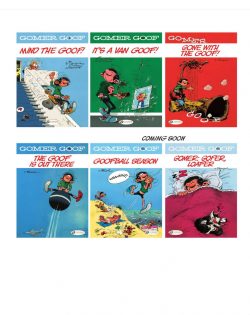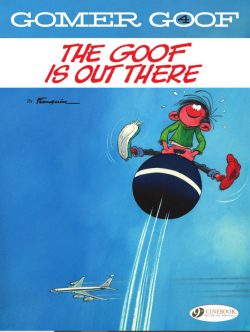

By Franquin, translated by Jerome Saincantin (Cinebook)
ISBN: 978-1-84918-439-7 (PB Album/Digital edition)
Like so much in Franco-Belgian comics, it started with Le Journal de Spirou. The magazine had debuted on April 2nd 1938, with its engaging lead strip created by Rob-Vel (François Robert Velter). In 1943, publishing house Dupuis purchased all rights to the comic and its titular star, after which comic-strip prodigy Joseph Gillain (Jijé) took the helm for the redheaded kid’s exploits. Ultimately the publisher would become a character in its own periodicals publications…
In 1946 Jijé’s assistant André Franquin was handed creative control of the Spirou strip. He gradually switched from short gag vignettes to extended adventure serials, introducing a broad, engaging cast of regulars and in 1952 created phenomenally popular wonder-beast The Marsupilami. Debuting in Spirou et les héritiers, this critter grew into a spin-off star of screen, plush toy stores, console games and albums in his own right. Franquin continued crafting increasingly fantastic tales and absorbing Spirou sagas until his resignation in 1969.
Franquin was born in Etterbeek, Belgium on January 3rd 1924. Drawing from an early age, the lad only began formal art training at École Saint-Luc in 1943. When the war forced the school’s closure a year later, he worked at Compagnie Belge d’Animation in Brussels, where he met Maurice de Bévére (AKA Lucky Luke creator “Morris”), Pierre Culliford (“Peyo”, of The Smurfs and Benny Breakiron) and Eddy Paape (Valhardi, Luc Orient). All but Peyo signed on with Dupuis in 1945.
Franquin began his career as a jobbing cartoonist and illustrator, producing covers for Le Moustique and scouting magazine Plein Jeu. During those early days, Franquin and Morris were tutored by Jijé, at that time chief illustrator at LJdS. He made them – and fellow newbie Willy Maltaite (AKA “Will” – Tif et Tondu, Isabelle, Le jardin des désirs) – into a smoothly functioning creative bullpen known as La bande des quatre or “Gang of Four”. They would ultimately revolutionise Belgian comics with their prolific and engaging “Marcinelle school” style of graphic storytelling…
Jijé handed Franquin all responsibilities for the flagship strip part-way through Spirou et la maison préfabriqué (#427, June 20th 1946) and eager office junior ran with it for two decades; enlarging the feature’s scope and horizons until it became purely his own. Almost every week fans met startling new characters like comrade and rival Fantasio or crackpot inventor and Merlin of mushroom mechanics the Count of Champignac…
Spirou & Fantasio became a globetrotting journalist team, visiting exotic places, exposing crimes, exploring the fantastic and clashing with a coterie of bizarre and exotic arch-enemies. Throughout all that, Fantasio was still a full-fledged reporter for Le Journal de Spirou and had to pop into the Dupuis office all the time. Sadly, lurking there – or was it just in the artist’s head? – was an accident-prone, smugly big-headed office junior in charge of minor jobs and dogs-bodying. Franquin called him Gaston Lagaffe…
There’s a long history of fictitiously personalising those mysterious back room creatives and all the arcane processes they indulge in to make our favourite comics, whether it’s Stan Lee’s Marvel Bullpen or DC Thomson’s lugubrious “Mr. Editor” and underlings at The Beano and Dandy. Let me assure you that it’s a truly international practise and the occasional asides on text pages featuring well-meaning foul-up/office gofer Gaston (who debuted in #985, cover-dated February 28th 1957) grew to be one of the most popular components of the comic, whether as short illustrated strips or in faux editorial reports in text-feature form.
On a strictly personal note, I still think current English designation Gomer Goof (this name comes from an earlier, abortive attempt to introduce the character to American audiences) is unwarranted. The quintessentially Franco-Belgian tone and humour doesn’t translate particularly well (la gaffe translates as “blunder” not “idiot”) and the connotation contributes nothing here. When he surprisingly appeared in a 1970s UK Thunderbirds annual as part of an earlier syndication attempt, Gaston was rechristened Cranky Franky. Perhaps they should have kept that one or, best of all, his original designation…
In terms of actual schtick and delivery, older readers will recognise beloved beats of Benny Hill and Jacques Tati in timeless elements of all-consuming, grandiose self-delusion, and recognise recurring situations from Some Mothers Do Have ’Em or Mr Bean. It’s all surreal slapstick, paralysing puns, infernal ingenuity and invention, pomposity lampooned and no good deed going noticed, rewarded or unpunished…
As previously stated, Gomer makes his living (let’s not dignify or mis-categorise what he does as “work”) at the Spirou editorial offices: occasionally reporting to go-getting journalist Fantasio, complicating the lives of office manager Léon Prunelle and other staffers, generally ignoring the minor design jobs like paste-up, “gofer-ing” and office maintenance he’s paid to handle. There’s also editing readers’ letters… the official reason why fan requests and suggestions are never answered…
Gomer is lazy, peckish, opinionated, ever-ravenous, impetuous, underfed, forgetful and eternally hungry, with his most manic moments all stemming from “inventing”, cutting work corners and stashing or illicitly consuming contraband food in the office…
This leads to constant clashes with police officer Longsnoot and fireman Captain Morwater, yet the office oaf remains eternally easy-going and incorrigible. Only two questions are really important here: why does Fantasio keep giving him one last chance, and what can gentle, beguiling, flighty, impressionable, utterly lovelorn secretary Miss Jeanne possibly see in the self-opinionated idiot?
Originally released in 1969 as the sixth collection of Le Journal de Spirou strips Gaston – Un gaffeur sachant gaffer, this fourth Cinebook compilation eschews longer cartoon tales and comedic text “reports” from the comic’s editorial page to deliver non-stop all-Franquin comics gags in single-page bursts.
It begins at the New Year and here the office hindrance – as ever – invents stuff that makes life harder for everyone; amiably passes on bugs and ailments; sets driving records no one can believe or probably survive and scotches attempts by financier De Mesmaeker (in-joke analogue of fellow creator Jidéhem – real name is Jean De Mesmaeker ) the explosively irate businessman whose ever-failing efforts to get his contracts signed render him a constant foil for and unfortunate victim of the Goof…
There is also an unwelcome return for his devastating musical invention as the recurrent saga of his truly terrifying Brontosaurophone/Goofophone continues to disrupt commerce, glass, the environment and most organic life in earshot…
Set in snowy, foggy wonderlands, Gomer disastrously pioneers powered ice skating before revolutionising record keeping and book storage with his mechanical successor to ladders, prior to embarking upon an extended sequence of episodes wherein Gomer’s attempts to do away with unsightly, annoying, constantly shedding Christmas tree needles results in the birth of a monster. He should never have dabbled with glue and pressure hoses, but at least he had his Goofophone music to console him…
All too soon, though, he’s back to breaking laws physicists consider sacrosanct – such as when he began dabbling with perpetual motion technology – or upsetting traffic cops, firemen and clients. Somehow, always and in all ways, the Goof keeps letting down his colleagues and employers, like when he decided to fix the big clock on the building exterior, or tweaked the overstretched office fuse board to accommodate his new secret electric stove…
Many strips involve manic efforts to modify the motorised atrocity he calls his car: an appallingly decrepit and dilapidated Fiat 509 auto(barely)mobile desperately in need of his many well-meant attempts to counter its lethal road pollution. It’s the reason he always has the sniffles or wears some kind of bandage, plaster or splint…
At heart, though, Gomer is a Good Samaritan and champion of animals. Many strips here prove how his love of all creatures great and small trumps minor considerations like personal safety, traffic laws or city ordinances, even though his distinctly novel approach to cookery borders on criminal perversity…
This time out there’s also a deep concentration on home – and office – improvements and novel – if somewhat risky – variations on established and beloved sports all given a fresh makeover by the unique innovator, such as when he showed Prunelle and Fantasio how he had beefed up bouncy amusement “the spacehopper”…
And he should never ever have been allowed to bring his chemistry set to work…
In this volume, we meet his opposite number from across the road. Jules-from-Smith’s-across-the-street is a like-minded soul and born accomplice always eager to slope off for a chat, and a devotee of Gomer’s methods of passing the time whilst at work. He even collaborates on such retaliations as Gomer inflicts on officer Longsnoot…
Far better enjoyed than précised or described, these strips allowed Franquin to flex whimsical muscles and even subversively sneak in some satirical support for his beliefs in pacifism and environmentalism. However, at their core the gags remain supreme examples of all-ages comedy: wholesome, barbed, daft and incrementally funnier with every re-reading.
Have you started Goofing off yet?
© Dupuis, Dargaud-Lombard s.a. 2009 by Franquin. All rights reserved. English translation © 2019 Cinebook Ltd.
